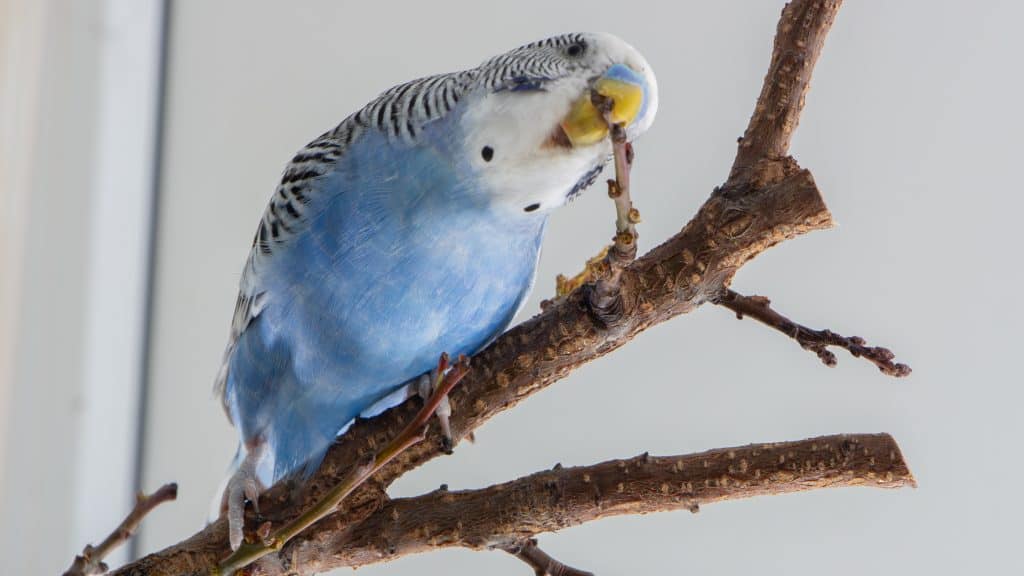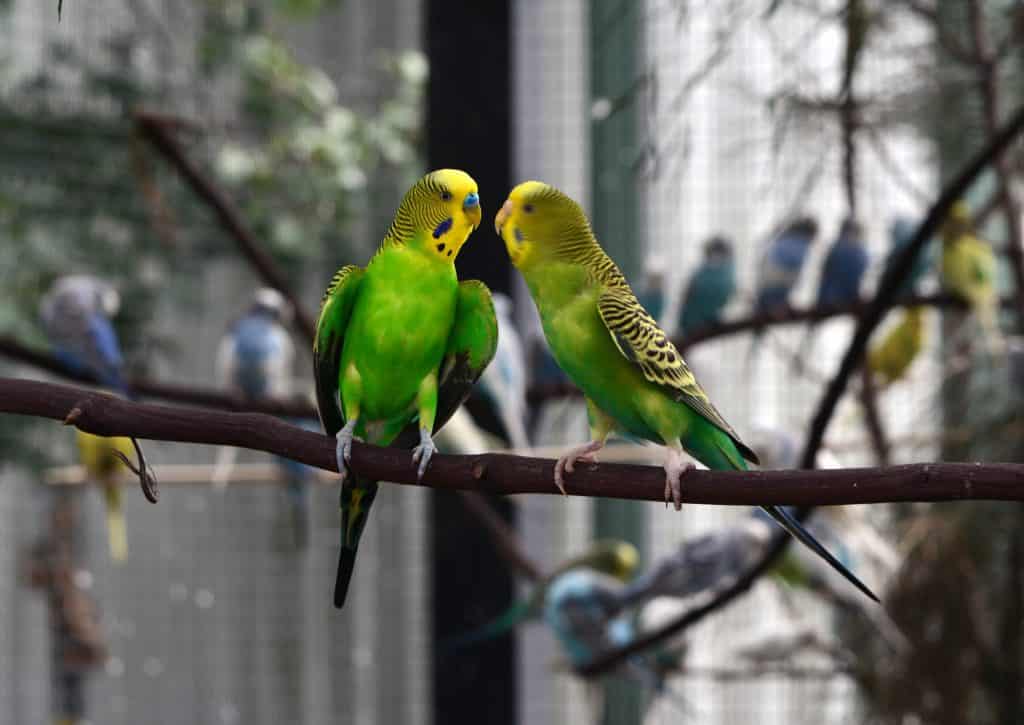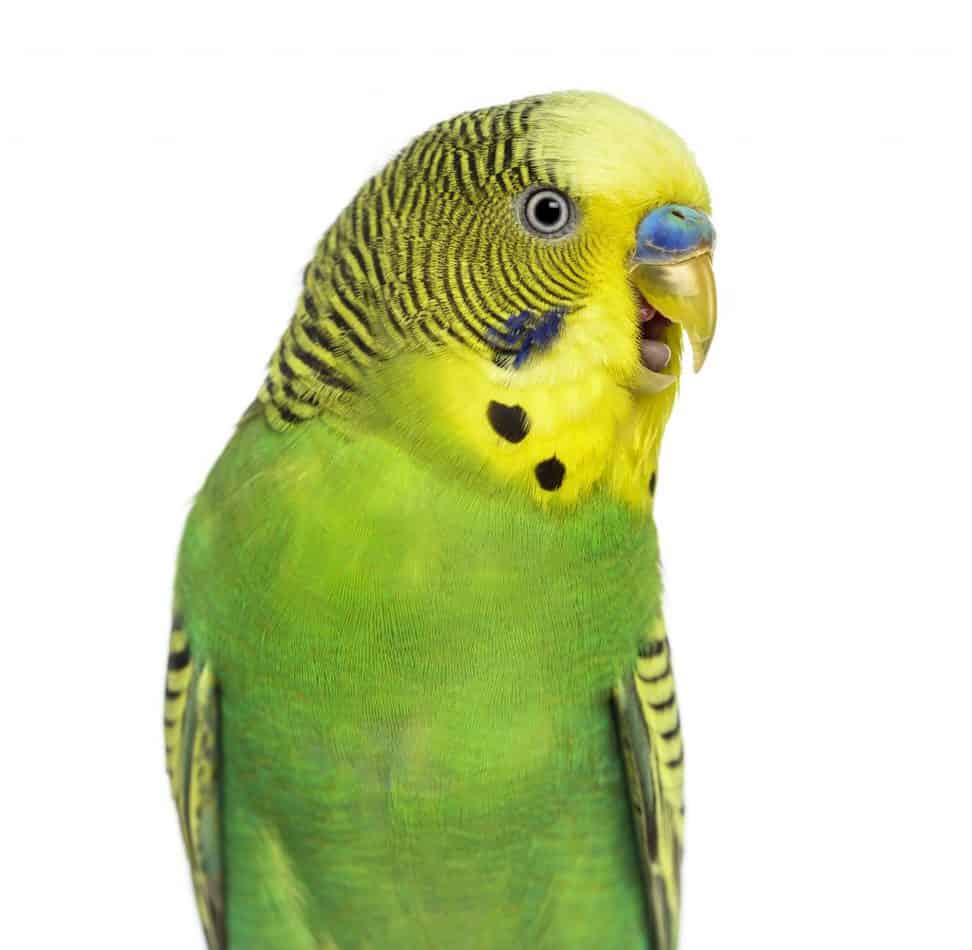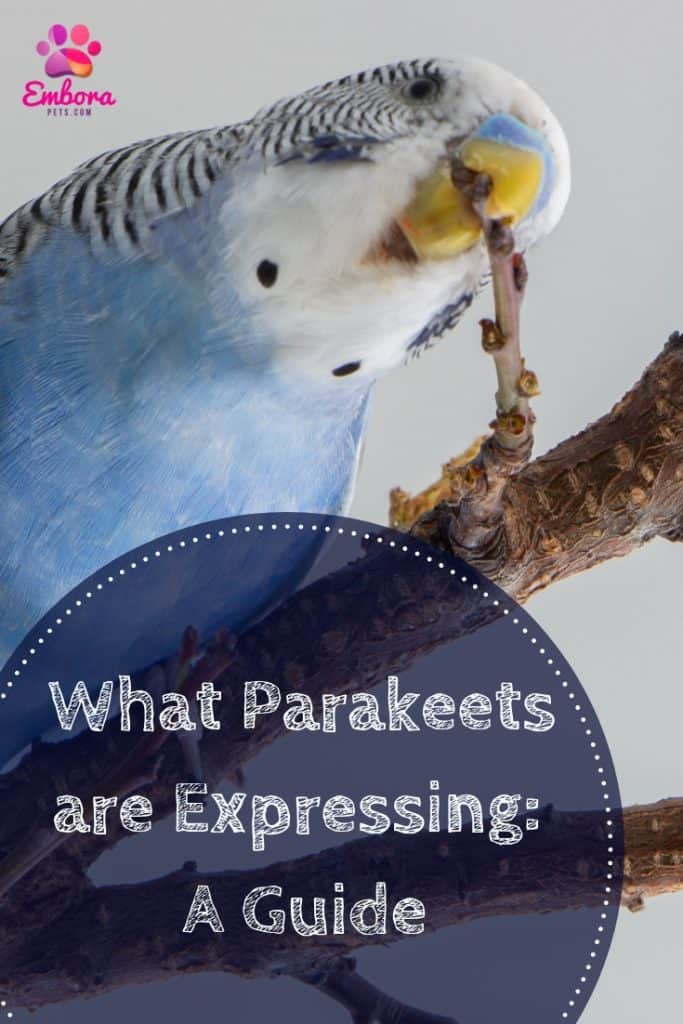Parakeet Behavior Guide: How to Know What They are Expressing
Parakeets (also known as budgies) are unique in that they have many ways of communicating with other birds and humans. But some of these communication tactics or devices can be confusing. In this article, I will tell you some ins and outs of the language of parakeets, and how to know what they are trying to tell you.

How can I understand Parakeet Behaviors and What they Mean?
Parakeet’s body language and spoken behavior, including talking, tweeting, singing, mimicking, screaming, regurgitating food, biting, plucking feathers, wing flapping, trembling, and head bobbing, are all ways these pet birds communicate. Female parakeets may be less talkative than male parakeets, but they still communicate in other ways.
Parakeet Behaviors:
- Talking, Tweeting, Singing and Mimicking = Happy
- Screaming = Fear or Pain
- Regurgitating Food = Affection
- Biting = Threatened, Afraid
- Plucking Feathers = Boredom, a Skin Condition, or Allergy
- Wing Flapping = Attention Seeking
- Trembling = Fear
- Head Bobbing = Mating, Socializing or H
unger
Budgies are pretty easy to read, but it is still crucial that we learn their language the best we can. It is also important to remember that each individual bird is different, so it’s important to spend time with and pay attention to your birds, and know what’s normal for them, and what’s not.
The best way to do that is to find out what they’re trying to say when they do certain things. Here’s how to learn what baby parakeets are saying and raise them well.
Happiness/Contentment
In general, budgies are very happy and content birds. Often you will find them singing a song, or talking. They do this when they are happy, or cozy. This will vary of course with different budgies. Some are very rambunctious and others are timider.
But, noises are not the only thing that budgies do to show that they are content! Sometimes they’ll flap their wings excitedly which shows that they are healthy and content.
They’ll often do it after a long rest as well. When they wake up they need to shake off their night and get their blood moving again, and their wing muscles ready to take flight.
If your parakeet is extremely enthusiastic or joyful, they might shake their tongue!
They often shake when they are happy as well! Not shake their whole body. That is a sign of something completely different. But, if they lightly shake their tail this is a good sign that they are content.
They’ll often do this when you return home to them after being gone all day. This behavior is a lot like when dogs wag their tails when we come home at the end of the day.
They also, if they are extremely enthusiastic or joyful, they might shake their tongue. They’ll open their mouth slightly, and waggle their tongue back and forth. This along with the shaking of their tail will remind you of a really happy or content dog.
What to Do:
Enjoy their contentment! Find what makes them happy and try to expand and multiply those experiences or toys. Your bird likes a certain food, remember to get that kind next time.
Do they particularly like a certain type of toy? Try to get many variants of that toy for your feathery friend to play with!
Affection/Attachment
Budgies are extremely social animals and have a lot of love inside of them to give out. If you give them the opportunities they soon will become a great companion who is both affectionate to you and attached to you.
If your bird is affectionate towards you, they won’t be afraid to show it. They will chirp to you, talk to you and even sing with you! They’ll bob their head and they’ll do whatever they need to try to communicate with you.
Another great sign that they are affectionate of you is if, when you can handle them, they are sitting on your shoulder and start lightly pecking at your ear or hair.
Budgies have a strong tendency to get very attached to things as well. This often will be an attachment to whatever they can find. Oftentimes, if a bird doesn’t have a natural mate or companion, different attachments are made. One kind can be made to certain toys.
This is common with bells because they move and make sounds that can mimic a bird’s high-pitched chirp. If you see this kind of obsessive attachment it’s time to think about getting your budgie a buddy.
A budgie’s most common sign of affection or attachment is them regurgitating their food into the mouth of their mate.
They also can become attached to you, or even their own reflection. If a mirror is in their cage, they’ll often become attached to the mirror because it looks like another bird.
A budgie becoming attached to its owner isn’t all that uncommon, because they are the ones caring for and socializing with them.
No matter how weird this may sound to us, a budgie’s most common sign of affection or attachment is them regurgitating their food into the mouth of their mate.
When it comes to toys, mirrors or even their owners, they will often try to regurgitate their food at us still, because that’s how they know how to show love.
What to Do:
Don’t be afraid to show affection back to your budgie. You can
Petting them will have to be on their conditions though, as some may not appreciate it. But, to try it out, pet them lightly on their head. If they like it they will relax and ruffle out their feathers.
Be warned though, don’t get too personal with the affection until you have taught your budgie that they can trust you but finger training them.
Trying to Communicate with Other Budgies

Budgies often communicate with the same tactics and ways that they do with their owners, which we will discuss later. But, briefly, budgies tend to communicate vocally, just as much as physically.
Certain communication tactics have a different meaning with other birds and humans.
Head bobbing is used in the mating process, male budgies will often bob their head while chirping happily for the female budgies. This usually leads to mutual feeding and then mating.
Head bobbing is a way of socializing for a parakeet.
Don’t be alarmed if you see your budgie bobbing its head at you. It is not trying to mate with you! This is not the only use of head bobbing.
With other budgies of the same family or gender or humans, head bobbing is a way of socializing for a budgie. Outgoing budgies are more likely to use this head bobbing social cue outside of mating, while more timid budgies are most likely to use it strictly for mating.
Baby budgies have yet another use for this head bobbing. This is how they communicate with their mothers (or other caretakers) that they are hungry! When squawking is involved it means that they are urgently hungry.
Head bobbing – used in the
Trying to Communicate with Owners
If you show appreciation or interest when your budgie bobs their head, they will start using this to communicate with you. It especially helps encourage them if you head bob back to them to get their attention.
When budgies use head bobbing towards their owner this often to just say hello. But, if there is some more intense chirping accompanied it can mean that they’re trying to get your attention for some reason.
This reason might simply be because they want your affection, or it may be because they are in need. Pay close attention to other signs in their body language that they are distressed.
Another way that budgies attempt to get their owner’s attention is by flapping their wings. If they’ve been sleeping for a long time, and they’re hovering above their perch flapping their wings hard, this is usually just a sign that they’re stretching and warming up rather than trying to get your attention.
Parakeets may flap their wings to get their owner’s attention.
Communication that they use with most all and everyone in their lives is chirping, tweeting, and singing. These are
Along with these things, budgies can be taught to talk and whistle! They’re actually one of the most talkative parrot breeds. Teaching them certain words or phrases can be quite beneficial to improving communication and trust with your budgie.
It is strongly suggested to teach your budgie to talk before teaching them to whistle. This is because whistling is often easier and more fun for budgies. After learning to whistle they most likely won’t have the motivation to learn how to talk or say specific words.
What to Do:
Communicate back! Your bird will appreciate whatever attention you give it, but the better the interaction, the better the bond!
Watch your bird, talk to your bird, sing to your bird, and show interest when your bird is trying to communicate with you. Use their communication skills and tactics to communicate with them.
Boredom/Obsession
Unfortunately, budgies tend to get very bored with things very quickly. Because of this, there are certain things to watch for.
On the other side of this, while they may become bored with something in their cage, if they are lonely they may become obsessively attached to certain toys or other unnatural things.
When bored, a budgie may become subdued, restless or even depressed. These are all very bad things that can lead to worse things if not resolved. When a budgie is inactive, frazzled or sad they are not taking care of their bodies properly.
If your parakeet is plucking at its feathers, it may be bored.
Another behavior that will give your budgies boredom away is if they are plucking their feathers out. While this also may be a sign of illness, allergy or disease, no matter the cause this is unhealthy behavior, and it needs to be resolved.
Like recently said, the opposite side of the boredom is naturally
Either a toy or object in their cage or a mirror, something will make them feel like there is another living thing there. And they can become obsessed with what they think is a new friend. Like said, budgies are very social and need that socialization just as humans do.
What to Do:
Budgies are very curious and will examine anything you put in their cage, but after they’ve fully investigated it, and played with it for a
It is crucial to rotate the toys in the cage every few days to avoid letting your budgie getting bored or obsessed.
Also, be sure to pay attention to your budgies needs. If they need another bird friend, try to make that happen. Also, be sure that you’re spending plenty of quality time with them.
Anxiety/Fear

Some other emotions that you will need to watch for closely in your budgie is anxiety or fear. The behaviors that indicate these emotions are a lot like the ones we see in ourselves, so it is not hard to discover when your budgie is feeling fearful.
Although they are incredibly loud most of the time, screaming is not normal for a budgie. A light scream might be let out every once in a while if they get too excited, but again, the tone of your budgies vocal behaviors will be what gives it away.
If
your parakeet lets out a genuine scream, that is definitely something to be concerned about.
A budgies body language when fearful will include several things. Most often, when scared they will tremble. Their whole body and wings will shake. This is almost always not a good sign.
It either means they’re scared or that they’re cold, which can indicate illness. Whenever there is trembling, find the source and put a stop to it.
Another tell-tell sign that a budgie is scared is that they will hunch their bodies down and try to become as tiny as possible.
Like humans, if scared, there is a chance a budgie can become aggressive. They may try to nip or bite. Be aware of this and try to eliminate the things stressing your budgie out before intervening. This may cause you to get in harm’s way.
What to Do:
The best you can do in this situation is to try to find the source or cause that scared them and eliminate that. Sometimes its a fleeting source from outside and you can’t do much other than try to distract your
If your bird is out of the cage, try to calmly help your bird into its
Remember to watch for signs of aggression from your budgie to ensure that no one gets hurt.
Protective/Threatened/Frustrated
When it comes to these aggressive or irritated emotions it’s important to notice as soon as possible and try to either let them cool off or reduce the tension. So how can you know that they are feeling these emotions?
One behavior that can signal annoyance is purring. With cats, this is a sign of contentment, but with budgies, it is a sign of frustration. If purring because of something you did, it is good to give them some space.
If it was another source that caused this annoyance, try to eliminate that source as soon as possible. This can also be a sign of relaxation though, so be sure to notice other verbal and physical behaviors to figure which emotion your budgie is feeling.
In parakeets, o
ne behavior that can signal annoyance is purring.
Other behaviors that can mean that your budgie is feeling threatened or frustrated, are a lot like those of other animals. They’re known to bite when provoked.
Usually one can tell when they’re going to bite though. They stare at their target, watch intently as the open their beak and that should give enough time to retreat from the situation.
Sometimes they will even let out a deep growl or a long hiss!
What to Do:
At this point just leave your bird alone and give him some time to cool off. You don’t want to risk further agitating your bird. Giving your bird some alone time will help him to cool down and keep everyone safe.
Illness/Pain
It is very important to pay attention to sign that your budgie might be in pain or getting sick. If these signs are ignored your budgie could get very sick or even die.
One thing that is common is when a budgie is sick, is in pain or has an illness they may start plucking their feathers out. No matter the cause this is not a good sign. But it also might be of boredom. When analyzing if your budgie is sick be sure to look for several of these behaviors.
Other behaviors to watch for is if your bird is particularly lethargic and kind of stays in one spot of the cage. Budgies are usually very active animals, so any kind of change in this energy is something to notice.
They also might lose their appetite and start eating a lot less or stop eating at all! This is a major behavior to watch for. Budgies need their energy and nutrients. If they stop eating and won’t start back up again pretty quickly, it is crucial that they are taken to the vet.
Sick parakeets might lose their appetite and start eating a lot less or stop eating at all!
Depending on the bird or the sickness they may be more irritable than usual. This is where it is important to know and interact with your bird. This way you can pick up on even the slightest attitude changes, and how extreme they are.
Most likely they will also puff out their beak and ruffle their feathers up to make themselves look bigger than they actually are. This helps them to increase their body heat.
Health Note: Most sicknesses and illnesses in budgies are because they got too cold. Since they are tropical birds they need to remain in 70-degree weather in order to remain healthy.
What to Do:
If your budgie is doing several of these things most or all of the time, they need to be taken immediately to a vet (preferably one who specializes in birds). They could have a number of very serious illnesses including respiratory infections. These illnesses could lead to death.
Related Questions:
Do budgies recognize their owners?
Do budgies bond with their owners? Budgies and other birds as well are very emotional and strive off of the attachments they make. Often birds will make these emotional bonds with a human rather than other birds, especially if that bird is raised away from its flock.
What are the signs of a budgie dying? Difficulty breathing, breathing with an open beak, tail bobbing when taking a breath, discharge around the nares, sneezing, and/or wheezing or clicking sounds. If these things start to occur get your budgie to the vet immediately.
Related Articles Just For You!
If you found this article about Parakeet behavior helpful, I suggest checking out one of these other articles.
- Parakeets (also known as budgies) have many ways of communicating with other birds and humans.
- Understanding their behaviors is important to know what they are trying to say.
- Talking, tweeting, singing, and mimicking show happiness; screaming shows fear or pain; regurgitating food shows affection; biting shows being threatened or afraid; plucking feathers shows boredom, skin condition, or allergy; wing flapping shows attention seeking; trembling shows fear; head bobbing shows mating, socializing, or hunger.
- Each bird is different, and spending time with them is important to know their normal behaviors.
- Budgies are happy birds that show contentment by singing, talking, flapping their wings, and shaking their tail or tongue.
- Affectionate birds show attachment by singing with you, pecking at your ear or hair, becoming attached to things, and regurgitating their food.
- Showing affection back can be done by bobbing your head, singing with them, or petting them lightly.
- Budgies communicate with the same tactics with other budgies, such as singing, talking, and head bobbing.







